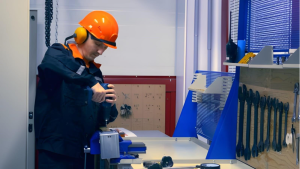
In today’s highly competitive retail and manufacturing environment, efficiency is everything. Companies that can streamline their operations without compromising quality gain a significant advantage. Nowhere is this more evident than in the realm of manufacturing assembly solutions. From in-store displays to nationwide rollouts, speed and precision go hand-in-hand.
At We Install It, we understand how vital it is to balance assembly speed with accuracy—especially when dealing with complex product lines or large-scale installations. Whether you’re managing product displays for multiple stores across Canada or assembling high-touch items like BBQs and bicycles, improving your assembly process can directly influence customer satisfaction, sales, and overall brand image.
So how do you make your assembly more efficient while ensuring that not even a single screw is misplaced? Let’s dive into actionable, tested strategies.
1. Standardise Processes for Consistency and Speed
One of the most impactful ways to streamline your operations is to create standardised procedures. Every aspect of your assembly—from unpacking components to securing final bolts—should follow a documented, repeatable system. This helps eliminate guesswork, ensures consistent quality, and speeds up training for new staff.
For example, using standard operating procedures (SOPs) can:
Reduce time spent making decisions on the fly
Prevent costly mistakes from inconsistent methods
Improve onboarding processes for technicians
Manufacturing assembly solutions that rely on uniform steps not only ensure high standards but also reduce the chances of overlooking small yet critical details. Moreover, SOPs can be revised and improved as new tools or technologies emerge.
2. Leverage Pre-Assembled Components and Modular Design
Whenever possible, use pre-assembled components and modular designs to cut down on time-intensive work at the final location. By doing some of the work off-site, you can speed up on-site assembly without sacrificing precision.
This approach benefits multiple stakeholders:
Technicians enjoy faster assembly with fewer parts to manage.
Retailers reduce store disruption during installations.
Customers get faster access to finished products.
This strategy is particularly useful in large-scale manufacturing assembly solutions, such as national rollouts or multi-location displays. We Install It uses this approach frequently for retail clients who want rapid implementation without quality setbacks.
For instance, display shelving units, pergolas, or trampoline frames can be partially built at a central location and finished on-site, reducing both cost and complexity. Think of modularity as your cheat code for speed and scale.
Adopting a modular approach also simplifies troubleshooting. Since modules are often uniform, diagnosing faults or conducting repairs becomes more straightforward.
3. Invest in Technician Training and Upskilling
Even with the best tools and systems in place, your assembly’s precision still depends on the skill level of your technicians. That’s why continuous training is a non-negotiable component of streamlining efforts.
Key areas of training to focus on include:
Tool handling for various materials (metal, wood, composite)
Reading schematics and blueprints accurately
Time management and site coordination
Best practices for clean, secure installations
Upskilled technicians can spot potential issues before they arise, follow SOPs more efficiently, and work confidently in diverse settings. We Install It employs over 3,900 licensed, insured, and background-checked experts. Their professionalism and training are what allow us to guarantee precision—even at speed.
Technician empowerment doesn’t stop at skills. Equip your team with real-time communication tools, job management apps, and feedback loops that let them share field insights instantly.
4. Integrate Smart Tools and Technology
The digital transformation of assembly is well underway—and for good reason. The use of smart tools can exponentially increase both speed and accuracy.
Here’s how technology helps:
Barcode scanning speeds up inventory checks
Augmented reality (AR) can guide technicians step-by-step
Digital torque wrenches prevent over-tightening
Assembly apps provide real-time updates and checklists
Smart tools ensure each task is done right the first time, reducing rework. For example, an assembly technician working on a display unit in Edmonton can follow the exact same digital guide as their counterpart in Ottawa. This guarantees precision while keeping the pace brisk.
Implementing digital checklists or mobile inspection tools also builds accountability into your process. Every completed step can be logged and verified on-site, ensuring nothing is missed.
5. Optimise Workflow with Lean Methodologies
Lean principles—originating from Toyota’s production system—focus on eliminating waste and maximising value. By analysing your current assembly workflows, you can identify redundancies, bottlenecks, and activities that don’t add value.
Key areas of improvement may include:
Minimising movement between tools and parts
Reducing time lost in handoffs or coordination
Cutting down on excessive inventory or materials
Apply the “5S” approach:
Sort: Remove unnecessary tools and parts
Set in Order: Organise for efficiency
Shine: Keep the area clean
Standardise: Maintain uniformity
Sustain: Commit to ongoing improvements
This methodology is particularly effective for companies scaling up and managing manufacturing assembly solutions across multiple sites.
6. Schedule Strategically to Minimise Downtime
Even the most skilled technician can’t make up for poor scheduling. That’s why efficient project management plays a major role in balancing speed with precision.
Strategic scheduling includes:
Avoiding peak store hours for in-store assemblies
Pre-planning deliveries to align with technician arrival
Allocating buffer time for unexpected challenges
When you’re handling manufacturing assembly solutions on a national scale, coordination is key. A delay in one location can cascade across the entire project. By using scheduling software and creating detailed roll-out calendars, you can keep things running like clockwork.
Learn more about our coast-to-coast manufacturing assembly solutions that stay on time and on budget.
7. Don’t Sacrifice Quality for Speed—Use QA Checkpoints
One of the biggest risks in streamlining is skipping quality checks. But in reality, building in QA checkpoints can actually enhance speed by preventing rework, complaints, and product returns.
Effective QA can include:
Visual inspection at each stage of assembly
Functionality tests (e.g., does the BBQ ignite properly?)
Structural checks (e.g., frame sturdiness for trampolines)
These checks don’t have to slow you down. When embedded into SOPs, they become second nature. And when paired with digital tools, they can be documented and tracked in real-time.
At We Install It, our 1-year labour guarantee shows that we take quality seriously. It’s why clients across Canada continue to trust our precision-driven service.
Final Thoughts: Achieving Precision at Scale
In retail and commercial settings, precision doesn’t have to come at the expense of speed. In fact, with the right systems, training, and technology in place, they can enhance each other. The goal of every business should be to create a repeatable, scalable, and precise assembly system that works no matter where or how often it’s deployed.
With decades of experience and over 3,900 expert technicians across Canada, We Install It is your trusted partner for efficient, high-quality assembly and installation. From national rollouts to local setups, we deliver manufacturing assembly solutions that are fast, reliable, and precise.



